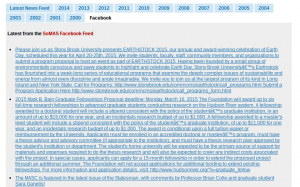This is Part 2 of my write up on the SoMAS Website. This post discusses the changes I have implemented on the existing website created by AWP from 2011 to late 2014.
Alumni Database and People Directory
Lists of our alumni were available on the SoMAS website as six different pages, organized by either MS or PhD. Updating the alumni lists was quickly identified as a tedious process, where multiple pages of the same content existed and could be easily missed in an update. If one page was updated, the webmaster needs to remember to update the other page as well.
Similar to the lists of Alumni, the People directory was a large list of names presented in entirety on a single master page but also separated across multiple pages identifying specific groups: faculty, staff, post docs, etc. Again, if a single page was updated, the updated information needed to be replicated across the other pages, manually.
The alumni information presented on the website is not the complete record of data we have for an alumnus. The alumni information migrated from a FileMaker Pro database to an Excel spreadsheet to a Share Point list. On the Share Point list, one view concatenates the data into an html list, which can be directly copied in the SoMAS website.
Using a small javascript library, List.js, I was able to display this single list of alumni and allow the viewer to sort, arrange and search the database how they chose. List.js was also able to organize the People directory in the same way. Now, instead of having to update over a dozen pages of replicated content, only two needed to be updated.
News/Research/Student Front Page Briefs
One problem with the base Apache installation that was used on the SoMAS webserver is that it simply functions as a page that can serve HTML and PHP documents. The server is easily described as a file cabinet filled with folders that contain pages to be displayed. There isn’t a clean “news” feature where periodic content can be posted and dated and provided through an RSS feed. In that absence, periodic content was “faked” by manually creating a new folder with a date and adding the files into the folder appropriately.
The SoMAS home page included a set of five periodic windows that highlighted the latest news article, the latest student update, the latest research highlight, the next scheduled seminar and the current weather conditions. The first upgrade to this section was to provide a quick link to the previous news entries, so that someone could quickly find a recent headline right from the main page without much additional clicking.
On the Seminar Schedule window, this page was quickly updated to an automated Google Calendar Agenda widget that connected to the Google Calendar feed for the SoMAS Calendar of Events. With the Google Calendar widget, this page no longer needed to be updated manually.
Weather Data
The weather data provided on the webpage changed as the weather stations were upgraded. Originally, the South P Lot weather station data was provided to the SoMAS page through a few different “hops” as the data was sent from the station, to the first receiver, to another server where it finally ended up on the web page. The Southampton Weather station data was presented in rather complete form, with graphs and images where available, but also took a few “hops” to get to the final location.
As the knowledge of Davis Weather Stations grew, it was discovered that the stations could easily upload data to Weather Underground and the Citizen’s Weather Observation Program. Links to that content provided visitors an easy way to compare daily data without building that infrastructure on the SoMAS website.
Social Media
 Links to the SoMAS Facebook page existed from the start, but a link to our Twitter feed was added shortly after the Twitter account was created. Eventually, an RSS feed of the Facebook page was added that pulled the social media links onto the web page so that visitors who did not have a Facebook account (or did not know that SoMAS had a Facebook page) would be drawn to that content. The RSS feed (seen in the image to the right) listed Facebook posts as links on the web site that pulled the Facebook post into the text.
Links to the SoMAS Facebook page existed from the start, but a link to our Twitter feed was added shortly after the Twitter account was created. Eventually, an RSS feed of the Facebook page was added that pulled the social media links onto the web page so that visitors who did not have a Facebook account (or did not know that SoMAS had a Facebook page) would be drawn to that content. The RSS feed (seen in the image to the right) listed Facebook posts as links on the web site that pulled the Facebook post into the text.
Archives
